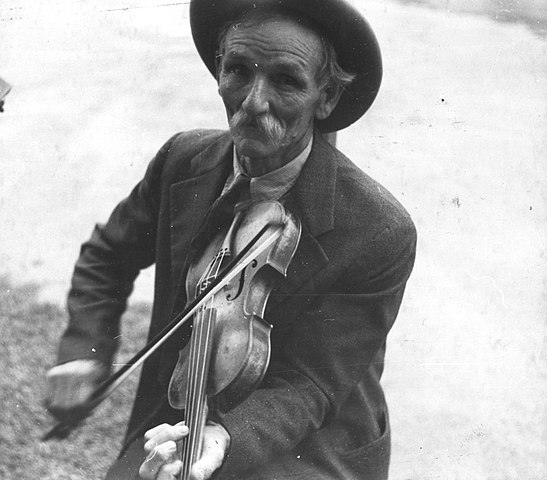
Asheville, North Carolina circa 1937
Our musical abilities are limited. Diane played clarinet in the high school band and Don’s musical capabilities would not fill up a thimble. It is from that personal perspective that we view with amazement the innate abilities of the people of Appalachia who not only can sing without musical accompaniment but can also build and play their own musical instruments.
The music of Appalachia was shaped by Native American, English, Scottish, Scotch-Irish, and African influences. The early settlers of this mountainous region that spans 1,500 miles from Maine to Georgia came from the northern latitudes of Europe. They were mostly Scot-Irish and English who brought their Gaelic and Balladeer music to the mountains. When coal mining became a major industry in the mountain region, the African-Americans began migrating to this area. This cross-pollination of musical culture created the unique Appalachia sounds and music.
Life was hard in the Appalachian Mountains and money was short. For many, they had no power, no telephone, no television and little transportation to go to town for entertainment. For them, gathering the family and friends on the porch to sing after the chores were done was a way of life. The Nitty Gritty Dirt Band song Louisiana Saturday Night epitomizes the life style of many country folks. While not centered on Appalachia, it shows that family singing together was an integral part of life in many areas. One verse of the song goes:
“Well you get down the fiddle and you get down the bow, kick off your shoes and you throw ’em on the floor, dance in the kitchen till the morning light Louisianan Saturday night”
Johnny Cash’s song, “Daddy Sang Bass” written by Carl Perkins and Bob Dylan is another example of family singing: “I remember when I was a lad, times were hard and things were bad.
But there’s a silver lining behind every cloud. Just poor people, that’s all we were, trying to make a living out of black land dirt. We’d get together in a family circle singing loud.”
As with the song Louisanna Saturday Night, the Appalachia music was initially limited to fiddle playing until near the end of the nineteen century when the banjo was added. In the twentieth century when this style of music began to gain in popularity, string bands were formed that added the guitar, bass, mandolin and sometimes other instruments such as the dulcimer. This music went on to become the genre of Bluegrass and Country music. Many of us might remember the more notable performer names of Roy Acuff, Hank Williams, Doc Watson, Grandpa Jones, Lester Flat and Earl Scruggs, Ricky Scaggs, Bill Monroe, Red Rector, Cass Walker, Mother Maybelle Carter and many others. But it is the unknown names that were the backbone of the Appalachia music that you seldom hear about. And it was the families who gathered on their porches and in their cabins to entertain themselves that are the important ingredient of this music.
The fiddle, the principal instrument of the Appalachia music, was the hardest to build unless you were a skilled craftsman. The craftsmen who built the fiddles had special forms in which to mold the fiddle pieces. A tool kit had to be purchased in order to create these instruments. On therefore the other hand, the banjo and mandolin took fewer skills while the guitar took a few more. Many of the Appalachia people were able to create their own instruments. When we think about these instruments today, we see the highly polished wood and metal versions of them for which you might have to mortgage your worldly possessions in order to afford. But the typical Appalachia versions of these instruments were built more simply. The Museum of Appalachia in Clinton. TN has one of the best collections of these home-made musical instruments. There you will find instruments made from gourds, large animal jaw bones, metal ham cans, bed pans, cigar boxes and many more items.
Susie Helton of White County, GA whose family lived in a cove in the Blue Ridge Mountains told us about her father building musical instruments so her family could entertain themselves. He created a banjo for himself and a guitar for Susie’s mother. The banjo base was formed from what appeared to be a wooden barrel stave bent into a circle and held with small bolts. The animal skin cover is missing but was likely a ground hog hide held on with metal clips known as bracket hooks. Adding the banjo neck, strings, tuning pegs and bridge some of which were likely purchased from a mail order catalog created a finished banjo. Using these same creative skills, he also built the guitar. Susie wanted to play the piano but they could not afford one so she made a piano keyboard out of a cardboard cut-out and made believe she was playing along with her mother and father. Susie said her mother knew all the Gaelic songs and the family would sing together until time to go to bed.
Susie’s story was repeated hundreds of times over for many of the families that lived in the Appalachian Mountains and in the back country of the valleys. In one of our research trips into Meriwether County, GA, Charlie Rowe told us about the Moody family all of whom lived on Moody Road. He said they would gather on the porch of one of the houses and played their musical instruments and sing. Charlie said they didn’t like folks coming to hear them play but if you got close you could be entertained for hours.
This music which was originally played for family and friends migrated to the churches and with the added capability of “shape notes,” whole congregations could join in and sing along. Many of the gospel quartets got their start learning to sing in the mountain community churches. Vestal Goodman was a singer who performed in the Southern Gospel genre for more than half a century. One of her well known songs she performed on the “Gaither Homecoming” series was “The Little Wooden Church on the Hill.” Part of the chorus to that song goes “You could hear the people singing from half a mile away.”
In today’s world of I-phones, tablets, Xbox’s and other electronic wizardry, we see families sitting around each engrossed in their own electronic marvel and paying little attention to each other. Perhaps, it is time to chuck all those devices and go back to building musical instruments and gathering the family together to sing. Maybe we could overcome some of the family troubles that seem to be more prevalent in today’s society.







